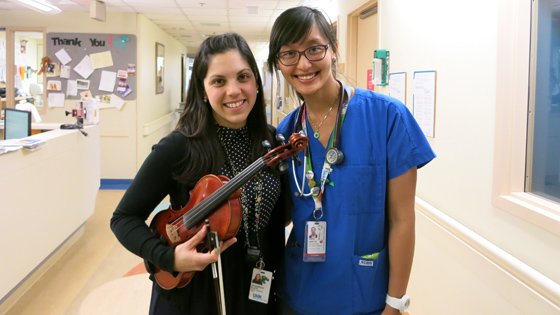
SarahRose Black, music therapist, Princess Margaret (left) and Tenzin Namgyal, nurse, Multi-Organ Transplant Unit, Toronto General (right), led a music therapy pilot this January to help patients manage pain. (Photo: UHN)
For six weeks this winter, Multi-Organ Transplant (MOT) patients at Toronto General Hospital (TGH) participated in "music therapy hour" every Wednesday – a complementary therapy to help manage pain.
For Beverly Neapetung, this hour was transformative.
Music therapy pilot project: first on MOT Unit
Neapetung, 44, was diagnosed with Idiopathic Pulmonary Fibrosis (IPF) in 2005. In 2013, she received a double-lung transplant at TGH.
In January, she participated in the music therapy pilot project on the MOT Unit, led by Tenzin Namgyal, nurse on MOT and Nephrology, and SarahRose Black, music therapist, Psychosocial Oncology and Palliative Care at the Princess Margaret Cancer Centre.
"This program was a great way to socialize with other patients – we're all in the same position, regardless of how long we've been here," said Neapetung. "I've met people I wouldn't have otherwise – people I can share my story with."
Music and managing pain
Namgyal introduced the pilot project as part of her Collaborative Academic Practice (CAP) Innovation and Research Fellowship, a UHN program providing healthcare professionals with opportunities to improve patient care through leadership and interprofessional collaboration.
"I've always had an interest in pain management," said Namgyal. "With our patient population, this is a huge issue and I wanted to offer a complementary therapy to oral pain management."
Namgyal connected with music therapist, SarahRose Black.
Click the video above to learn more about SarahRose Black and her
approach to music therapy at Princess Margaret.(Video: PMCF/YouTube)
Songwriting sparks childhood memory
At the first music therapy session, some patients were hesitant, said Black, but after six short weeks, the energy and enthusiasm from patients and staff was overwhelming.
"The first session is always challenging," said Black. "But over time, people start to build trust – music is a quick avenue for forming meaningful relationships."
Black implemented a combination of interactive and receptive music therapy techniques. She encouraged patients to engage in songwriting, which was particularly popular. Patients anonymously shared a few thoughts, and Black sang and played their words back with piano accompaniment.
"Music lets your mind wander to a moment," said Neapetung. "One time, when SarahRose played, it took me back to Christmas time at my grandparents' house. My grandfather played the fiddle and we would listen and dance."
Merging music and medicine
The patients' capacity to participate in music therapy initially surprised staff on the Unit. Patients who struggled to get out of bed or into a chair six weeks earlier were suddenly mobile and in better shape for rehabilitation.
"It's exciting that music therapy can help other patients," said Black, whose specialty is oncology. "For me, this experience was another reminder of how music can touch everyone."
Survey results conducted after each session indicated most participants felt it was a "safe place to express themselves", scoring sessions a seven or eight out of 10.
"Some of our patients actually integrated music therapy into their care plans," said Namgyal. "Wednesday afternoons became a time nurses would look forward to, and some even attended the sessions. This was something really positive for both patients and staff."
While the successful pilot project has ended, Namgyal is looking into ways to integrate music therapy into more patient care plans on the MOT Unit.
Namgyal will present her findings to the CAP program at the end of March.
